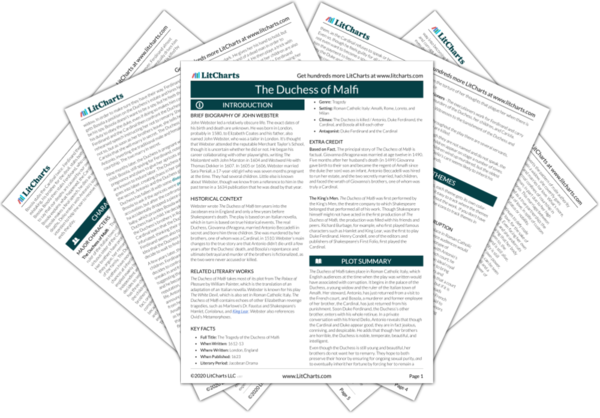Welcome to the LitCharts study guide on John Webster's The Duchess of Malfi. Created by the original team behind SparkNotes, LitCharts are the world's best literature guides.
The Duchess of Malfi: Introduction
The Duchess of Malfi: Plot Summary
The Duchess of Malfi: Detailed Summary & Analysis
The Duchess of Malfi: Themes
The Duchess of Malfi: Quotes
The Duchess of Malfi: Characters
The Duchess of Malfi: Symbols
The Duchess of Malfi: Literary Devices
The Duchess of Malfi: Quizzes
The Duchess of Malfi: Theme Wheel
Brief Biography of John Webster

Historical Context of The Duchess of Malfi
Other Books Related to The Duchess of Malfi
- Full Title: The Tragedy of the Duchess of Malfi
- When Written: 1612-13
- Where Written: London, England
- When Published: 1623
- Literary Period: Jacobean Drama
- Genre: Tragedy
- Setting: Roman Catholic Italy: Amalfi, Rome, Loreto, and Milan
- Climax: The Duchess is killed / Antonio, Duke Ferdinand, the Cardinal, and Bosola all kill each other
- Antagonist: Duke Ferdinand and the Cardinal
Extra Credit for The Duchess of Malfi
Based on Fact. The principal story of The Duchess of Malfi is factual. Giovanna d’Aragona was married at age twelve in 1490. Five months after her husband’s death (in 1499) Giovanna gave birth to their son and became the regent of Amalfi since the duke (her son) was an infant. Antonio Beccadelli was hired to run her estate, and the two secretly married, had children, and faced the wrath of Giovanna’s brothers, one of whom was truly a Cardinal.
The King’s Men. The Duchess of Malfi was first performed by the King’s Men, the theatre company to which Shakespeare belonged that performed all of his work. Though Shakespeare himself might not have acted in the first production of The Duchess of Malfi, the production was filled with his friends and peers. Richard Burbage, for example, who first played famous characters such as Hamlet and King Lear, was the first to play Duke Ferdinand. Henry Condell, one of the editors and publishers of Shakespeare’s First Folio, first played the Cardinal.







